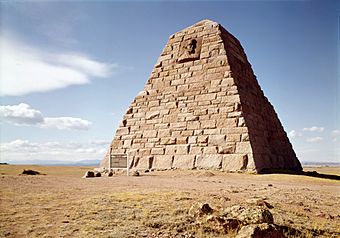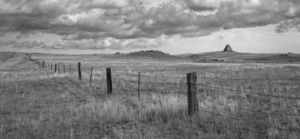Ames Monument facts for kids
|
Ames Monument
|
|

Ames Monument
|
|
| Location | Albany County, Wyoming, 3 mi (4.8 km) NW of Sherman |
|---|---|
| Nearest city | Laramie, Wyoming |
| Built | 1880-1882 |
| Architect | H. H. Richardson |
| NRHP reference No. | 72001296 |
Quick facts for kids Significant dates |
|
| Added to NRHP | July 24, 1972 |
| Designated NHL | October 31, 2016 |
The Ames Monument is a large pyramid in Albany County, Wyoming. It was designed by a famous architect named Henry Hobson Richardson. This monument is dedicated to two brothers, Oakes Ames and Oliver Ames, Jr.. They were important people who helped fund the Union Pacific Railroad.
This monument marks the highest point on the First Transcontinental Railroad. It sits at an elevation of about 8,247 feet (2,514 meters). A town called Sherman grew up around the monument. But later, the Union Pacific Railroad moved its tracks. This left Sherman to become a ghost town, meaning people moved away and it became empty.
Oliver Ames was the president of the Union Pacific Railroad from 1866 to 1871. His brother, Oakes, was a U.S. representative from Massachusetts. Oakes had a lot of control over building the railroad. In 1873, Oakes was involved in some financial problems related to the railroad's funding. He resigned from his position and passed away soon after.
Contents
Designing the Ames Monument
The Ames Monument is about 20 miles (32 km) east of Laramie, Wyoming. It stands on a windy, treeless hill near Interstate 80. The monument is a four-sided pyramid. It is 60 feet (18 meters) wide at its base and 60 feet (18 meters) tall. It's made from light-colored granite stone found in the area.
The famous American architect H. H. Richardson designed this pyramid. It features two large portraits, called bas-reliefs, of the Ames brothers. These portraits are 9 feet (2.7 meters) tall. They were sculpted by Augustus Saint-Gaudens and are on the east and west sides of the pyramid's top. Saint-Gaudens carved these portraits from granite.
On the north side of the monument, which once faced the railroad tracks, there are large letters. They say: "In Memory of Oakes Ames and Oliver Ames." This monument is one of several projects Richardson designed for the Ames family.
The Ames Monument is one of only two examples of Richardson's work west of the Mississippi River. The other is a house in St. Louis. The monument is built with large, rough granite boulders. Some of the stones at the base are huge, measuring five feet by eight feet and weighing thousands of pounds. The pyramid gets narrower as it goes up, making it look very strong and solid.
Building the Transcontinental Railroad
Building the transcontinental railroad in the 1860s was a huge challenge. It was like a "mission to Mars" for its time: very big, expensive, and seemed almost impossible. President Abraham Lincoln reportedly told Oakes Ames that if he could get the railroad built, he would be "the most remembered man of the century."
Lincoln personally asked Oakes to help. This was because the company building the railroad, Credit Mobilier of America, had stopped making progress and was running out of money. The Ames brothers succeeded where others had failed. They completed the transcontinental railway. However, in 1873, there were accusations of financial problems against Oakes. This affected his reputation and that of the Union Pacific Railroad Company.
The Ames family had a long history, dating back to 1774. Their company started by making steel-edged shovels. Later, they sold axes and shovels to miners during the California Gold Rush. They continued to be involved in big earth-moving projects. They supplied shovels for the government during the Civil War, for digging the Panama Canal, for mining in Pennsylvania, and for building the New York City Subway.
Why the Monument Was Built
Even though there were financial issues in 1873, the Union Pacific Railroad Company decided to build the monument honoring the Ames brothers. This happened between 1881 and 1882. The Union Pacific Railroad Board of Directors voted in 1875 to build the grand Ames Monument. They hoped it would help improve the company's image after the earlier accusations. The company's stockholders approved the construction in Boston on March 10, 1875.
The Norcross Brothers company built the monument. They had about 85 workers who lived right at the construction site. These workers cut the granite stone for the pyramid from nearby rock formations. Then, they used teams of oxen to drag the heavy stones about half a mile to where the monument was being built. Many of the rough granite blocks used weigh several tons.
The pyramid was built about 300 yards (274 meters) south of the railroad tracks on a small hill. When it was finished in 1882, the Ames Monument stood 300 feet (91 meters) south of the tracks. It was also 32 feet (9.8 meters) above the highest point of the original Union Pacific transcontinental railroad tracks. President Rutherford B. Hayes even attended the monument's dedication ceremony. This showed how important the transcontinental railroad and the Ames brothers were.
When the monument was completed, many people would visit it. They were allowed to briefly leave their trains to see this amazing structure. It was said that when the monument was almost finished, some people could be lifted to the very top. From there, they could see the surrounding area for a hundred miles in every direction!
Sherman: A Ghost Town
The small town of Sherman grew up at the site where trains would stop. This was north of the tracks, and trains would change engines there during their long journey across the country. The stop had a roundhouse with five stalls for engines and a turntable to turn them around. There were also two section houses and a windmill with a water tank.
Trains were checked at Sherman before they started the long trip down from the Sherman Pass summit. They would either go east towards Cheyenne or west across the 130-foot (40-meter) high Dale Creek Bridge to the Laramie Valley.
The town of Sherman eventually disappeared in 1918. The railroad company closed its station and moved the tracks about three miles (5 km) south. People soon left Sherman. Today, only a small cemetery remains there.
The Monument Today
Union Pacific gave the Ames Monument to the state of Wyoming in 1983. The monument is listed on the National Register of Historic Places. It is now cared for as a Wyoming state historic site. Over time, some parts of the bas-relief portraits of the Ames brothers have been damaged. The Ames Monument is open all year, as long as the weather allows.
Restoration work was done on the monument in 2010 and 2011 to fix it up. On October 31, 2016, the site was given National Historic Landmark status. This special recognition was given because of the unique teamwork between Richardson and Saint-Gaudens. They were two of the most important creative artists of their time.
See Also
- Dell Upton, Architecture in the United States, Oxford University Press, 1998, pages 96–97. ISBN: 0-19-284217-X.
Images for kids







